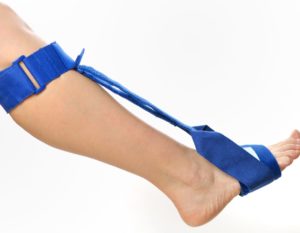 Drop foot is a condition that is categorized by the inability to lift the front part of your foot. This condition causes a person’s toes to drag along the ground while walking. People can avoid dragging their toes by lifting their legs higher than normal, or by changing another part of their gait.
Drop foot is a condition that is categorized by the inability to lift the front part of your foot. This condition causes a person’s toes to drag along the ground while walking. People can avoid dragging their toes by lifting their legs higher than normal, or by changing another part of their gait.
Why does this condition develop, and how can it be treated? We explore those questions and more in today’s blog.
Drop Foot Causes and Symptoms
Drop foot usually develops due to weakness or partial paralysis of the muscles that lift your foot. Because of this, it is generally a symptom of a larger issue as opposed to being a condition in and of itself. There are a couple of common causes of drop foot:
Nerve Injury – Foot drop can be caused by an injury to the peroneal nerve. If you are experiencing difficulty lifting the front of the foot along with pain or numbness along your shin or the top of your foot, it may be caused by peroneal tendon dysfunction. Your peroneal tendon can be damaged by diabetes or by acute trauma, but it can also be injured during childbirth, if you spend excessive time in a leg cast, or you routinely sit cross-legged.
Brain or Spinal Disorders – Genetic conditions and other disorders of the brain or spine can also contribute to foot drop. For example, neurological conditions like multiple sclerosis, cerebral palsy or a stroke can inhibit normal foot movement.
Muscle Disorder – Conditions that lead to progressive muscle loss or detrioration can contribute to drop foot. Issues like muscular dystrophy, amyotropic lateral sclerosis and polio can all lead to muscle weakness in the front of your foot.
As we mentioned above, since foot drop is generally a symptom of a larger condition, any symptoms that appear in conjunction with your inability to lift the front of your foot can give clues to an underlying problem.
Diagnosis and Treatment of Drop Foot
As you might have guessed, treatment of drop foot depends on the underlying cause. So in order to develop a treatment plan, doctors first need to get to the bottom of what’s causing the muscle weakness in the front of your foot. They’ll typically do this by conducting a physical exam, asking you about your symptoms and medical history, and then they may try to confirm some theories with imaging or blood tests.
Once your doctor has come to a conclusion as to what’s causing your drop foot, some treatment options will be laid out. Your specific treatment plan will be based on your exact condition and cause, but some common treatment methods for different cases of drop foot include:
- Braces
- Shoe inserts/Custom orthotics
- Physical therapy
- Surgery
Lightweight braces and physical therapy are the most common treatment options because when used in conjunction, they work to support the leg and strengthen the muscles of the foot. However, if your drop foot is caused by peroneal tendon damage, surgery to address the damage may be the optimal route. Surgery is also preferred if the drop foot is permanent, as doctors can work to improve gait and stability in the ankle and foot.